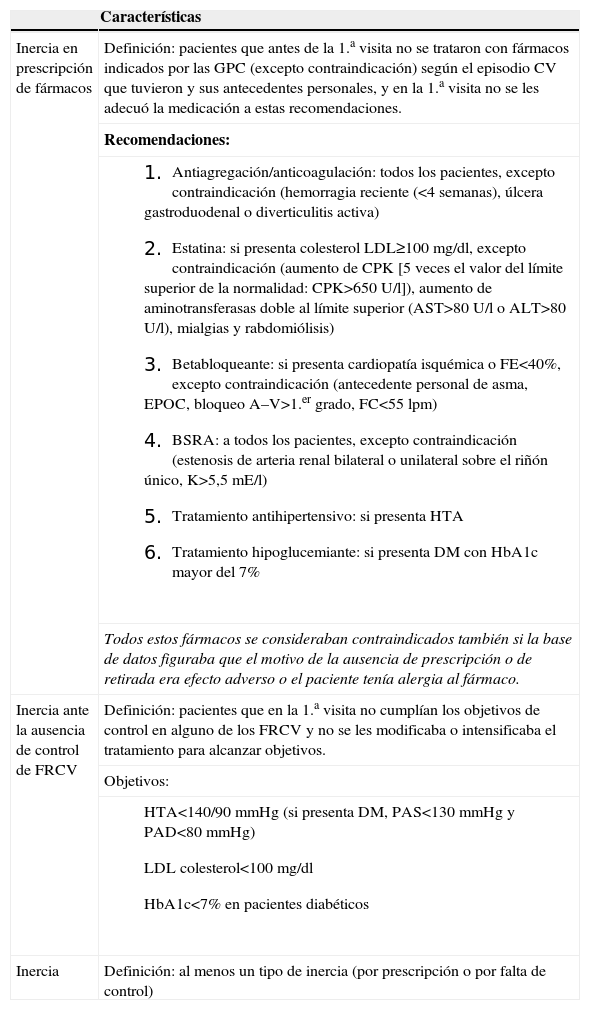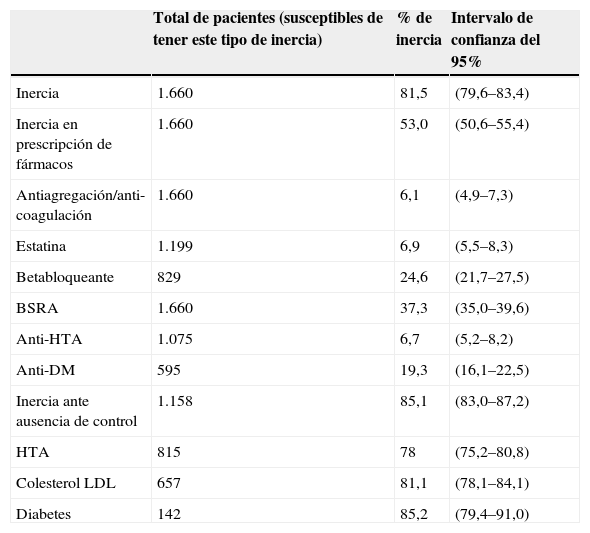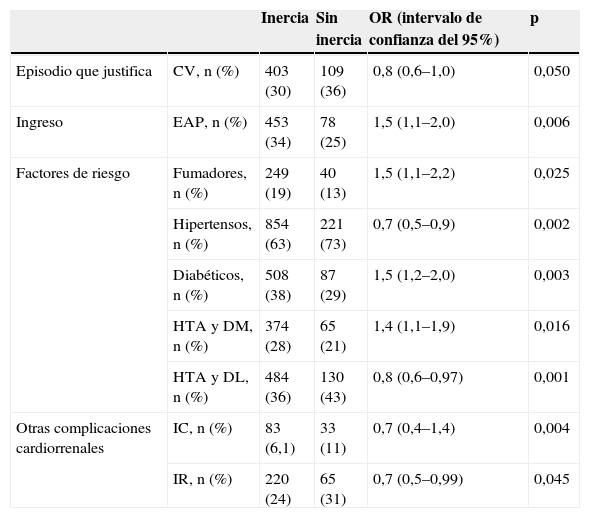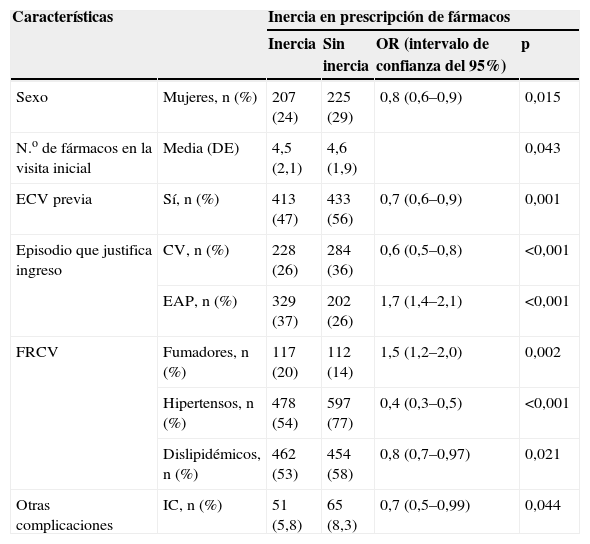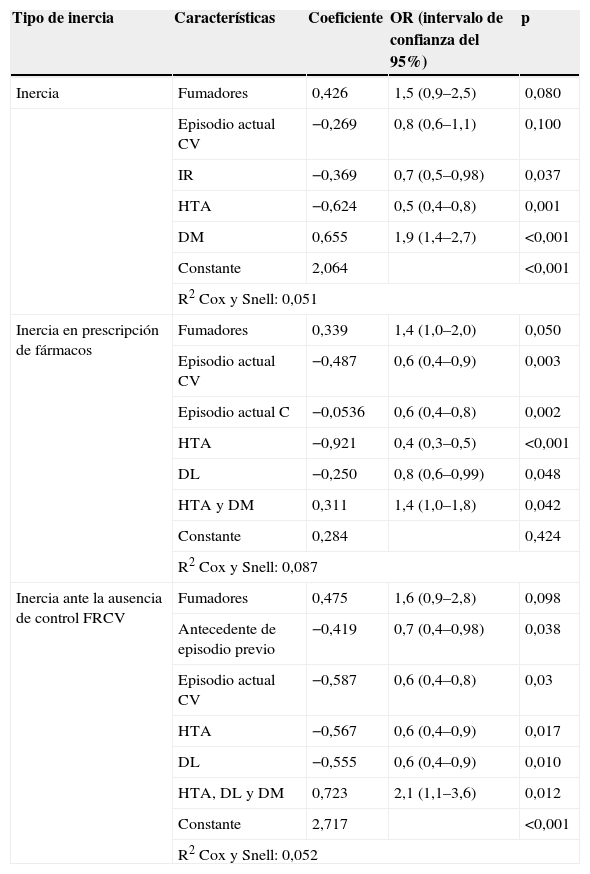A pesar de la existencia de múltiples protocolos y guías de actuación para el tratamiento de las enfermedades cardiovasculares (ECV), el grado de control de los factores de riesgo cardiovascular (FRCV) y la adecuación de las actuaciones a las recomendadas distan mucho de lo deseable. Al fenómeno de falta de actuación del médico a pesar de detectar un problema de salud, potencialmente mejorable, se le ha llamado inercia terapéutica (IT). Los objetivos del presente estudio fueron cuantificar la IT en pacientes en prevención secundaria de ECV e identificar los factores asociados a ésta.
Pacientes y métodoEstudio transversal y descriptivo, con 1.660 pacientes incluidos en el registro FRENA (registro nacional, multidisciplinario de pacientes en prevención secundaria de ECV). La edad media fue de 66,3 años, un 74% eran varones y el 38,5% tenía afectación coronaria, un 30,8% tenía afectación cerebrovascular (CV) y un 32% tenía afectación vascular periférica. La variable final fue la IT, de la que se distinguen 2 tipos: inercia por ausencia de prescripción de fármacos e inercia ante la ausencia de control de FRCV. Se define una tercera variable, inercia, como al menos una de las 2 anteriores. Se realizó un análisis univariante y multivariante para cada tipo de inercia.
ResultadosSe detecta inercia en un 81,5% de los pacientes. La inercia ante la ausencia de control de FRCV es del 85,1 frente al 53% por ausencia de prescripción de fármacos. Favorece la IT el ser diabético, mientras que la insuficiencia renal o la hipertensión arterial (HTA) protegen frente a ésta. La inercia en prescripción de fármacos es menor en la afectación CV o coronaria frente a la afectación periférica, en HTA y dislipidemia. La coexistencia de HTA, dislipidemia y diabetes mellitus favorece la inercia ante la ausencia de control, mientras que el antecedente de ECV previa, la afectación actual CV, la HTA y la dislipidemia la disminuyen.
ConclusionesEn pacientes de muy elevado riesgo, la IT está presente en un porcentaje muy elevado. La diabetes mellitus, la arteriopatía periférica y la coexistencia de FRCV se asocian a una mayor inercia.
Although nowadays there are many cardiovascular disease (CVD) treatment protocols and evidence based guidelines, not many patients achieve the recommended levels for cardiovascular (CV) risk factor (RF) and management of disorders could be improved. Treatment inertia (TI) is the failure of health care providers to initiate or intensify therapy when indicated. The purpose of this study was to quantify TI in secondary CV prevention and identify factors influencing TI.
Patients and methodObservational, transversal study with 1660 patients included in FRENA (The FRENA registry recruited Spanish patients in CVD secondary prevention treated by different specialists), aged 66,3 years, 74% males, 38,5% females, 38,5% coronary heart disease (CHD), 30,8% cerebrovascular disease and 32% peripheral artery disease (PAD). Final variable: TI; three types of inertia where described: treatment failure inertia, RF control inertia and the third one was at least one of the previous. Uni and multivariate analysis were done for each type of inertia.
ResultsInertia was detected in 81,5% of the patients. RF control inertia was 85,1% and treatment failure inertia 53%. Diabetic patients are likely to be treated with TI whereas patients with renal insufficiency (RI) or arterial hypertension (AHT) are more likely to be protected against it. There is less treatment failure inertia in cerebrovascular disease or coronary heart disease Vs PAD, AHT and Dyslipemia (DL) where the rate of treatment failure inertia is higher. RF control inertia increases with the coexistence of AHT, DL and diabetes mellitus (DM) and is lower in patients with previous CVD, cerebrovascular disease, AHT and DL.
ConclusionsIn high risk patient, TI is present in a high percentage of them. DM, PAD and the coexistence of cardiovascular risk factors are associated with a higher inertia.
Artículo
Comprando el artículo el PDF del mismo podrá ser descargado
Precio 19,34 €
Comprar ahora







